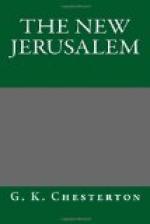We think of the desert and its stones as old; but in one sense they are unnaturally new. They are unused, and perhaps unusable. They might be the raw material of a world; only they are so raw as to be rejected. It is not easy to define this quality of something primitive, something not mature enough to be fruitful. Indeed there is a hard simplicity about many Eastern things that is as much crude as archaic. A palm-tree is very like a tree drawn by a child—or by a very futurist artist. Even a pyramid is like a mathematical figure drawn by a schoolmaster teaching children; and its very impressiveness is that of an ultimate Platonic abstraction. There is something curiously simple about the shape in which these colossal crystals of the ancient sands have been cast. It is only when we have felt something of this element, not only of simplicity, but of crudity, and even in a sense of novelty, that we can begin to understand both the immensity and the insufficiency of that power that came out of the desert, the great religion of Mahomet.
In the red circle of the desert, in the dark and secret place, the prophet discovers the obvious things. I do not say it merely as a sneer, for obvious things are very easily forgotten; and indeed every high civilisation decays by forgetting obvious things. But it is true that in such a solitude men tend to take very simple ideas as if they were entirely new ideas. There is a love of concentration which comes from the lack of comparison. The lonely man looking at the lonely palm-tree does see the elementary truths about the palm-tree; and the elementary truths are very essential. Thus he does see that though the palm-tree may be a very simple design, it was not he who designed it. It may look like a tree drawn by a child, but he is not the child who could draw it. He has not command of that magic slate on which the pictures can come to life, or of that magic green chalk of which the green lines can grow. He sees at once that a power is at work in whose presence he and the palm-tree are alike little children. In other words, he is intelligent enough to believe in God; and the Moslem, the man of the desert, is intelligent enough to believe in God. But his belief is lacking in that humane complexity that comes from comparison. The man looking at the palm-tree does realise the simple fact that God made it; while the man looking at the lamp-post in a large modern city can be persuaded by a hundred sophistical circumlocutions that he made it himself. But the man in the desert cannot compare the palm-tree with the lamp-post, or even with all the other trees which may be better worth looking at than the lamp-post. Hence his religion, though true as far as it goes, has not the variety and vitality of the churches that were designed by men walking in the woods and orchards. I speak here of the Moslem type of religion and not of the oriental type of ornament, which is much older than




